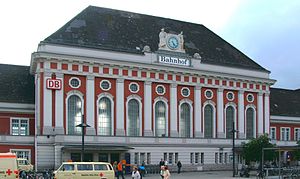Hamm station
| Through station | |

Station hall
|
|
| Location | Willy-Brandt-Platz 1b, Hamm, North Rhine-Westphalia Germany |
| Coordinates | 51°40′42″N 7°48′26″E / 51.67825°N 7.80724°ECoordinates: 51°40′42″N 7°48′26″E / 51.67825°N 7.80724°E |
| Line(s) |
|
| Platforms | 12 |
| Construction | |
| Architectural style | Historicism |
| Other information | |
| Station code | 2528 |
| DS100 code | EHM |
| IBNR | 8000149 |
| Category | 2 |
| Website | www.bahnhof.de |
| History | |
| Opened |
|
Hamm (Westfalen) (often abbreviated Hamm (Westf) or simply Hamm (W)) is a railway station situated in the city of Hamm in the German state of North Rhine-Westphalia. It is notable for its station building inspired by art deco and Gründerzeit building styles. The station is one of the important InterCityExpress rail hubs in the eastern Ruhr area and is among the high-profile buildings of Hamm. Until the decline of rail freight after the Second World War, it featured one of Europe's largest marshalling yards.
The station at Hamm was opened on 2 May 1847, when the first train of the Köln-Mindener Eisenbahn reached the city. It had been planned from the very beginning to make Hamm a railway hub, therefore the line to Münster (1848) and the line to Paderborn via Soest (1850) were opened soon thereafter. Both lines were built and operated by the Königlich-Westfälische Eisenbahn. Finally, in 1866, the Bergisch-Märkische Eisenbahn connected their line to Hagen via Unna to the growing station.
Due to the explosive increase in traffic at the height of the industrial age, the station was soon unable to cope with the growing demand. A separate marshalling yard was built in the 1880s, situated on the southern side of the passenger station. However, this did not provide real relief, and therefore the station area underwent major reconstruction starting in 1911 and finishing by 1929. The railway lines were laid on elevated embankments and the trackbed inside the station was raised, the old station building, originally built as an island platform, was torn down and replaced by the current building, the construction of which was finished by 1920.
...
Wikipedia
